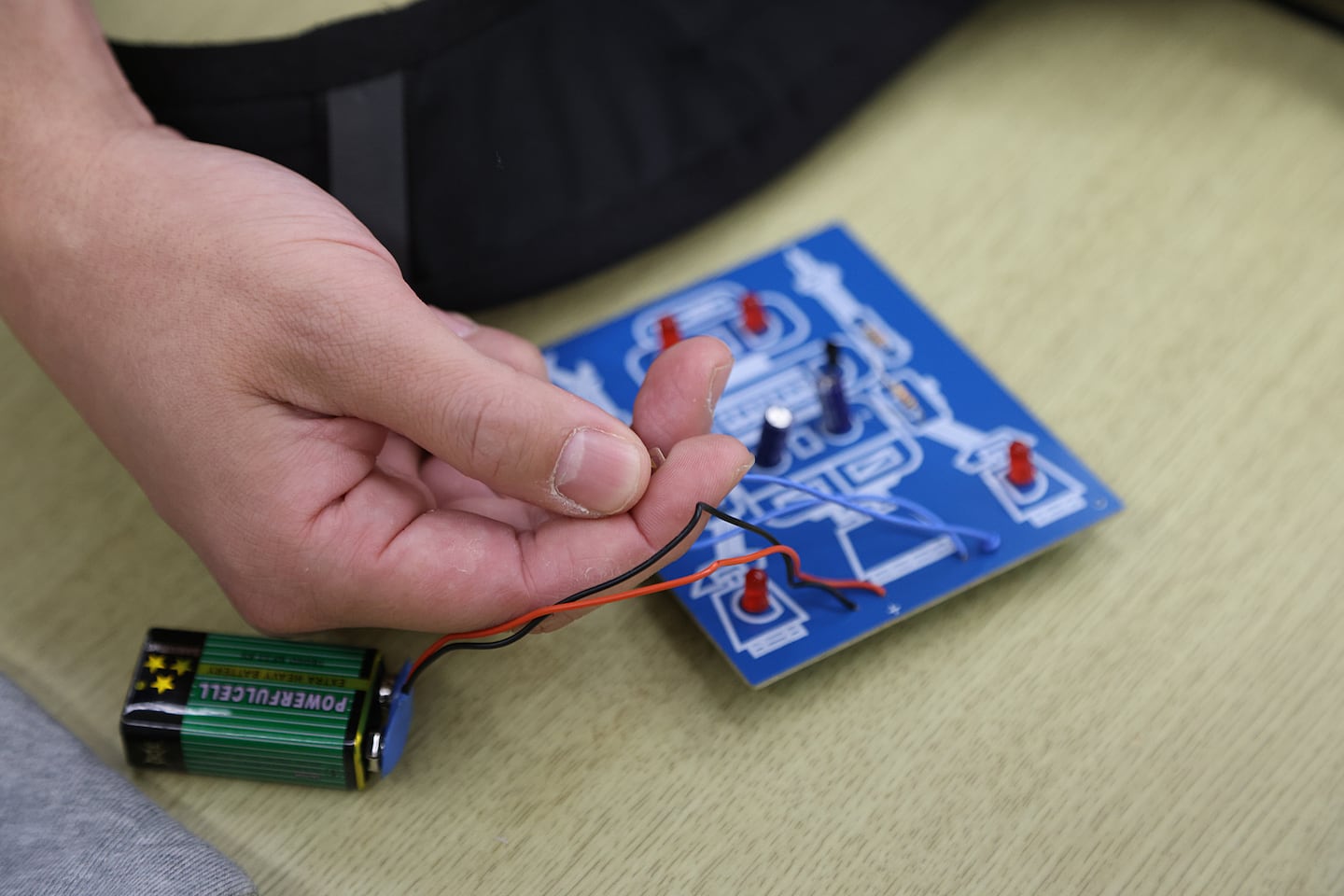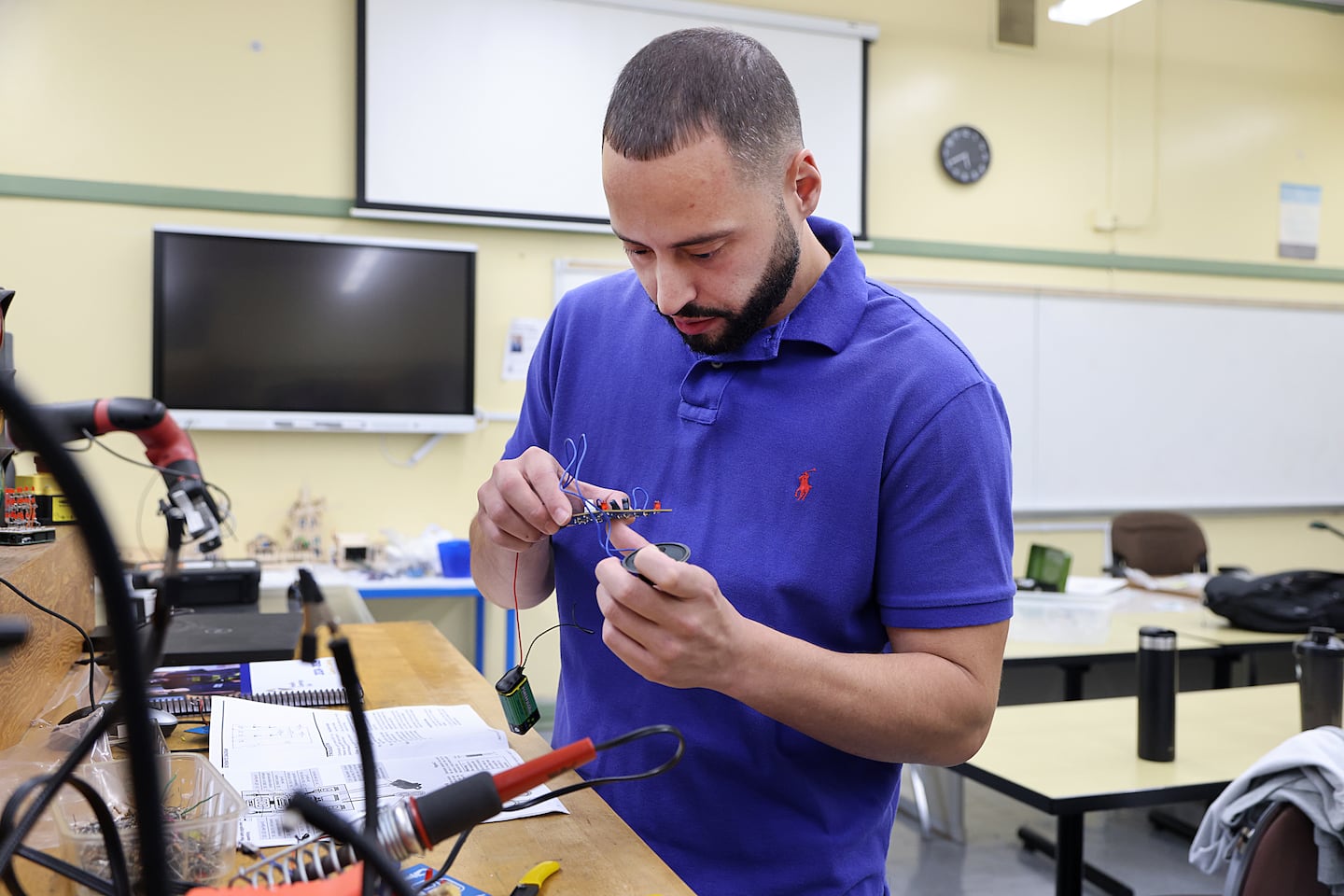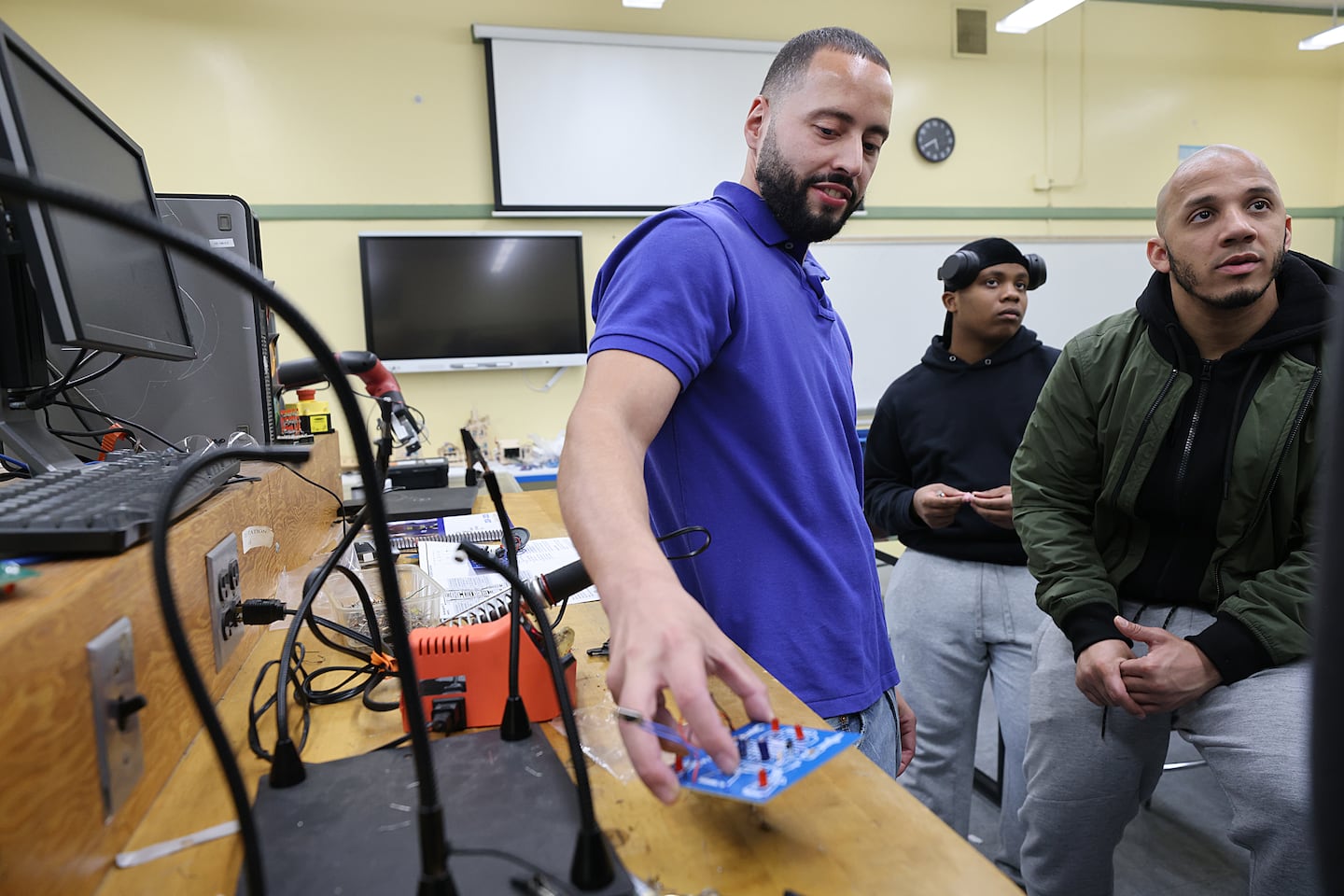From prison to green jobs: Ex-inmates among new workforce powering state’s climate goals
November 17, 2024
Gripping a soldering iron firmly in his right hand, Osvaldo Medina angled the tip toward the circuit board and prepared to attach a small red lightbulb. He watched puffs of smoke curl up as hot silver drops melted onto the board, fixing the bulb in place. Then he stepped back to admire his handiwork, passing the iron to one of his classmates.
“The state of Massachusetts is going green, and that’s the future,” said Medina, roughly two months into his Digital Principles class at the Benjamin Franklin Cummings Institute of Technology in Boston’s South End. “So I want to be ahead of the game, before it’s too late.”
Medina, 37, never imagined three years ago that he’d be working toward a degree in renewable energy technologies. After he left high school in the 11th grade and became entangled in dealing drugs, two decades passed before he picked his studies back up at the Boston Pre-Release Center, a minimum security prison that prepares men to return to their communities.
Now, home from prison, he is one of a handful of former inmates — and among scores of people of color often from working-class or poor backgrounds — starting training this year to break into Massachusetts’ clean energy sector, which is looking to fill 34,000 jobs in the next six years, including EV mechanics, wind turbine technicians, geothermal drillers, and solar panel engineers. Officials say the jobs are essential to meeting the state’s climate goals of slashing greenhouse gas emissions in half (compared to 1990 levels) by 2030, and becoming net zero by 2050.
“The general need for green jobs is … just massive,” said Zeyneb Magavi, executive director of HEET, a nonprofit dedicated to shifting buildings to be heated and cooled by renewable energy sources. The program, one of several in Massachusetts helping to grow the number of people of color in the industry, graduated its first cohort of geothermal drilling trainees in September.
“We have shifted from talking about the transition we need to actually building it,” she said, adding that “the skill and training and capacity of the workforce are what’s going to determine success.”

According to a report released by the state’s clean energy center last year, nearly 90 percent of clean energy employers reported difficulty finding workers. Meanwhile, the report found a higher percentage of Black and Latino residents are impacted by barriers to entry, with transportation, access to training, and effective communication (often due to language barriers) among the biggest hurdles.
For formerly incarcerated workers, having to explain their criminal record to employers is an additional challenge — one that staff at Cummings Tech and Boston Pre-Release’s School of Reentry are training their students to confront, and discussing early on with potential employers.
“A lot of it has to do with getting employers to understand examples of [other] employers that have hired talent with records, and have done well as a result,” said Damany Fisher, a Cummings Tech adviser focused on reentry, who cited businesses like Toyotetsu, an auto parts manufacturer that launched a second-chance initiative in 2018. “By doing this, not only are we helping our students get these jobs and reducing recidivism, but we’re also helping the employer meet their workforce needs.”
At Cummings Tech, a sign above one doorway reads: “Opening the door to a world / Where every individual / Can create a pathway to a viable career.” On campus, another formerly incarcerated student, Alexander Harris, said the social support he’s received from faculty — from mental health resources to personal finance 101 — has been just as critical as academic guidance as he works toward a certificate in HVAC and refrigeration.
“It’s what’s needed to really move in any career,” said Harris, 42. “It’s been years since I went to school … but I know my options are wide open now.”
The state operates a green jobs board, where employers can post openings, and also runs an internship program that offers mentorship and job-matching to first-generation or low-income college students looking to enter the clean energy sector. And the Healey administration announced a Climate Careers Fund earlier this year to inject a projected $10 million into publicly funded clean energy training, as well as another $16 million in grants to minority- and women-owned businesses in “climate-critical sectors” such as HVAC and electric vehicle charging and maintenance.
Massachusetts leads the nation in pay for clean energy jobs, with a median hourly wage of $29.84, roughly six percent higher than the statewide median wage, according to state data. Those wages are only expected to increase, with an expected median of $36.58 an hour by 2030.
To close the gap, a patchwork of nonprofits and community organizations have launched training programs or partnered with colleges to equip students with the resources to get ready for the fields that need them, and introduce them to industry employers.
HEET’s drilling readiness program focuses on installing geothermal heating and cooling for homes and businesses, while the nonprofit Local Initiatives Support Corporation offers a 10-week training in weatherization, the process of updating buildings for energy efficiency often through better insulation. Both programs reported enrollment of more than 94 percent people of color.

The Boston Pre-Release Center’s School of Reentry partnered with Cummings Tech to offer certificates and degrees in EV technology, building energy management, and renewable energy technologies to incarcerated students nearing the end of their sentence. Students can start taking classes on campus in the weeks prior to their release, and continue their coursework once they’re back home. The center also began receiving additional support from the anti-poverty organization Action for Boston Community Development this year, including helping students find a job after graduation.
“This is a talent that everybody should want. These guys are hungry. They want to work. They want to give back. They want to be productive citizens,” said Lisa Millwood, executive director of the School of Reentry. “So we’ve got to train them up, but we [also] really need to work on our employers to open their eyes and let them see that this is an untapped potential.”
Jennifer Applebaum, managing director of workforce development for the state’s clean energy center, said state officials are studying ways to empower low-income residents and people of color to pursue lasting careers in green industries, such as offering financial support to small businesses that want to expand professional development opportunities for their employees.
“We have to be committed to being right at the front edge of this,” she said, “ensuring that there are really robust workforce development pathways and that those pathways offer … not just entry into a first job, but also advancement.”
Jameail Beckett, 41, who returned home from prison in May, said he chose to pursue his associate’s degree in building energy management and engineering after completing his HVAC certificate to “do something better with my life, and show people I can be different than who I was.”
Growing up poor in Cambridge, Beckett said he became sucked into a life of dealing drugs in the eighth grade, and “didn’t stay in high school more than three days, because the money was calling to me more than the classroom.” Now, though, he sees the classroom as a pathway to a financially stable future.
“The way I was making money back then, it wasn’t good for me,” he said of his past experiences with drugs and robbery. “To be honest, me being a felon, it’s hard to get into my field [HVAC systems] right now. But I came home and am doing all the right things, so I just keep my head up, and hope a door will open somewhere.”

Ivy Scott can be reached at ivy.scott@globe.com. Follow her @itsivyscott.
Search
RECENT PRESS RELEASES
Related Post



